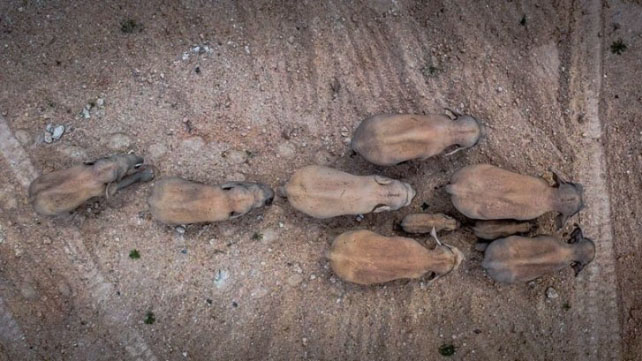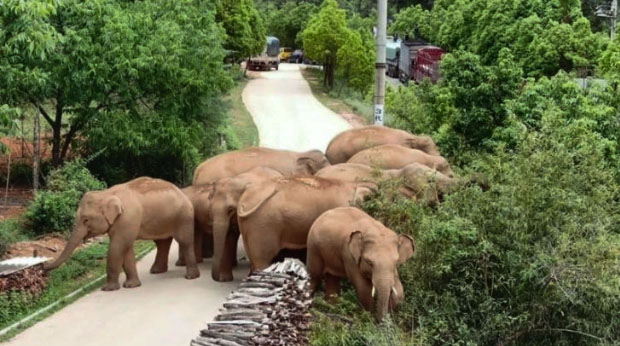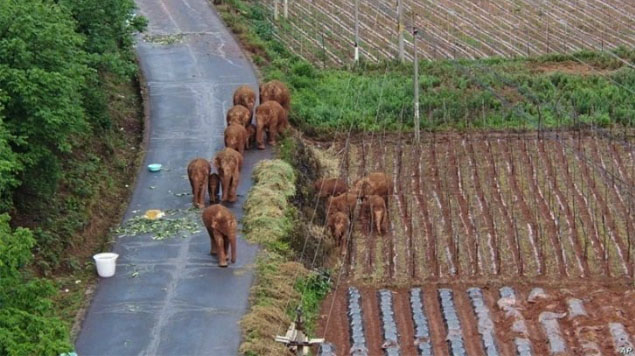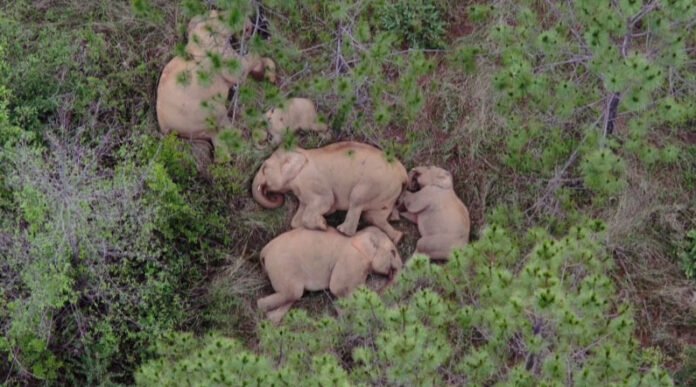An elephant herd of 15 elephants has been going on a journey across the Republic of China for nearly 15 months. This elephant herd, which includes 3 baby elephants, had successfully travelled more than 300 miles. It was surprising news even for scientists because journeying for such a long time within an unfamiliar environment is obviously a very rare behaviour that cannot be expected from animal species like elephants.

People from all around the world were so curious when they heard about the atypical journey of this elephant herd. However, this journey brought out the question of how effective the animal conservation practices in China are. Surprisingly, China, the country with the second-largest population in the world, is home to only 300 Asian elephants. It emphasises the fact that elephants are unsteady on the edge of extinction in China.
How does this herd of elephants survive during this wonderful journey? Why do we need to question the animal preservation practices of China? Is this a signal of the severity of human-elephant conflict? It is worth it to probe deeply into this matter to find answers to all the above questions.
The atypical journey of the elephant herd

The initial home of the elephant herd was the Mengyangzi Nature Reserve in Xishuangbanna. Xishuangbanna is a town in Yunnan province, southwest, China. On the way to find something that is still a secret, they even passed highly populated towns such as Kunming, which has a population of 6.6 million people.
Nevertheless, it is not completely correct to say that they just “passed” those towns because they also “destroyed” some valuable resources in those towns. This elephant herd damaged the majority of the crop in the town by eating it. On the other hand, they devasted the houses and buildings by breaking doors and windows. Since there is also a possible threat to people’s lives, the controlling figures in charge started to monitor the elephant herd throughout the journey. Approximately 500 officers and 14 drone cameras were incorporated to keep an eye on this elephant herd. Apart from safeguarding people’s lives, those control figures tried to force the elephant herd to go back to their original habitat, Mengyangzi Nature Reserve.

At one point, the elephant herd decided to lead their way back to the initial habit maybe because of human intervention in their journey, failure to fulfil their objectives or unsuccessful leadership of the herd. Moreover, it was reported that it is not an elephant herd with 15 elephants anymore but with 14 because one male elephant has separated itself from the others and has continued the journey 2.5 kilometers away from them.
The reason why this elephant herd decided to give up their familiar environment and why they decided to go back to that environment again are still mysteries to be figured out.
Animal Conservation Practices in China

This atypical journey questions how effective the Animal Conservation Practices in China are. We can assume this elephant herd decided to abandon their familiar habitat because they felt it was not safe or suitable anymore for them to live. Mengyangzi Nature Reserve has failed to create a safe and familiar environment that encourages elephants to stay. Because of all these reasons, Asian elephants have become endangered in China. Unfortunately, China is now home to only 300 Asian elephants. China should not forget that it is essential to pay more attention to preserving endangered elephants before they become totally extinct species of animals.
The growing population is one of the main problems China is facing these days. To build a sufficient number of residences for people, they always choose to compromise wildlife and nature reserves. Furthermore, this situation intensifies the human-elephant conflict due to the inadequate distinction between human and elephant habitats. Human-elephant conflict is a serious problem because it increases the vulnerability to both humans and elephants.
Although China has inaugurated a number of projects to solve this problem and protect wildlife, it does not seem like those practices have had a considerable positive impact on solving it. That’s why the failure of the Animal Preservation Practices in China has grabbed the attention of the entire world today. As a whole, it is a must to take effective measures to solve human-elephant conflict and protect elephant habitats at least from now on because elephants add precise value to the biodiversity of Mother Nature.
Severity of Human-Elephant Conflict and measures to prevent
Authorities in charge had failed to protect crops and houses from the damages made by this elephant herd during their journey, although those authorities consistently monitored the journey and intervened by closing roads or forcing them to go back to their initial habitats. Thousands of farmers had to face severe profit losses because of the devastation done by the elephant herd to their crops. Besides, a lot of people lost their residences due to the damage to their doors and windows. This is the severity of human-elephant conflict. When humans make elephants vulnerable to losing their habitats, elephants do the same to safeguard their existence. The human-elephant conflict must be solved or at least minimized, to ensure the safety of both humans and elephants.
As an immediate response to this problem, effective measures should be taken to study the behavioural patterns of elephants to understand the major difficulties they face. Those difficulties should be addressed as soon as possible to take control over the ongoing human-elephant conflict. To ensure the future control over this issue, China needs to focus on minimizing the impact of human activities such as agriculture and construction on wildlife. That should be the long-term goal of Animal Preservation Practices in China. Unfortunately, Asian elephants have become an endangered animal species in China, which only has 300 of them. But China should not forget that they need to play a lead role in Animal Preservation, which can encourage the entire world while focusing on the economic and financial growth of the country.
Conclusion
Some news about the atypical journey of an elephant herd from China has recently drawn the attention of the entire world. An elephant herd, which includes 12 adult elephants and 3 baby elephants, had decided to abandon their habitat and start a journey across Southwest China. They have travelled nearly 300 miles for 15 months, which is incredible to believe. Scientists were also surprised and confused to find the actual reason behind this journey. But this journey is obviously a hint of the human-elephant conflict in China and the drawbacks of the Animal Preservation Practices taken by them to prevent the conflict. Elephant herds had done serious damage to the crops and houses on the way, which created huge losses for the people. Elephants’ intervention in the humans’ lives is a reaction to humans’ interventions in elephants’ lives. So, the impact of human activities on elephants’ lives should be minimized to control this problem.
It is the responsibility of all of us to protect the harmony between humans and animals because the world should be a safe place for both. As individuals, we can also contribute to that by protecting the environment through effective measures like minimizing plastic usage and adding that waste directly to the environment.


